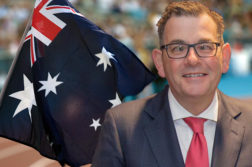With only two days to go before South Australia votes, Premier Mike Rann once again finds himself doing a lot of thinking about Independents.
His first term as premier in 2002 came thanks to the support of a former Liberal turned Independent, Peter Lewis. Lewis was made parliamentary speaker in return for his crucial vote, Rann led a minority government that he subsequently turned into a majority one in 2006 and Labor dominance became the accepted reality on North Terrace with no need for Independents at all.
But then there was Michelle.
By now there wouldn’t be a South Australian alive who hasn’t heard the rather grubby claims and counter-claims made by Michelle Chantelois and Mike Rann: sex in the office; sex on the golf course; a jealous husband; a magazine rolled into a truncheon. He said, she said, they said she said, and she says again and again to anyone who’ll listen.
Whatever the truth of the alleged affair, there’s one thing we do know for sure — Chantelois has been a very big rock landing in the placid pool of South Australian politics.
Prior to the assault on Rann by Chantelois’s husband and the subsequent furore, no one was in any doubt as to how the 2010 election would play out. Labor would coast home, retaining most of its majority, and life would go on as normal. Some commentators, including Clem Macintyre in newmatilda.com, appear to have adopted this as a default position, a fundamental assumption underlying their predictions. The facts, however, show a tectonic shift in the South Australian political ground.
The first factor that needs to be recognised is the state’s unique redistribution rules. Normally the inevitable variations in voter enrolment and attendance numbers in different electorates mean that, come election day, there is a difference in their sizes and therefore in the value of each vote. Different states do what they can to minimise this, periodically redistributing electoral boundaries to keep them roughly equal, but in SA there is a strange procedure whereby they redistribute after every election to make the seat-per-vote equation retrospectively "fair". They change the boundaries so that — had the two major parties each ended up with 50 per cent of the two-party-preferred vote at that previous poll — it would have been a hung parliament. In this way, the South Australian system attempts to clean up its own shortcomings after each election in preparation for the next.
But it also means that the results of one election can distort the following poll. Political scientist Peter Brent of the ANU, has pointed out that the previous election in 2006 saw Labor win 57 per cent of the two-party-preferred vote, after redistribution. But Labor’s "on-paper" or pre-distribution share of the two-party preferred vote was more than 57 per cent — it was closer to 59 or 60 per cent. That is, if the Liberal Party needed to win seven seats to reclaim government before redistribution, the seventh seat required a swing of 9 or 10 per cent, not merely 7 per cent.
This occurs because not all swings are uniform — in one seat in 2002 Labor may have seen a swing to it of 4 per cent, and in another seat it may have been 10 per cent. The redistribution rules adversely affect those electorates where the pro-Labor swing was greater than average, by redrawing boundaries so that the seat reflects the statewide result rather than the local one. Electorates that swung more than the State-wide average towards Labor are deliberately apportioned more Liberal areas and booths, and vice versa. Consequently, as Brent says, "the subsequent redistribution quite deliberately shaved 2 to 3 per cent off Labor’s margin."
This means, bizarrely, that a vote the same as in 2002, where Labor barely scraped in, could this year see Labor lose quite badly. Brent observes that the 2006 election was very unusual in the size of the Labor win, and basing redistribution on this may have unforeseen consequences if 2010 is close. In fact, the Liberals may even be able to win the election with under 50 per cent of the two-party-preferred vote.
It’s here that the recent Newspoll spells real trouble for Labor. Although Macintyre sees little danger in its finding of a 6 per cent swing, the peculiarities of the South Australian system mentioned above mean that the Liberals won’t actually need that big a swing to win government. As a result, even if — as Macintyre predicts — that possible 6 per cent swing isn’t evenly distributed across all the seats where it would count most for the Libs, they are still much closer than many realise to finishing this election in a position to form government.
The second factor in Labor’s decline is that the Chantelois affair has seen the party’s support among women, normally part of the bedrock of their electoral fortunes, crumble to horrendously low levels. The extent of the damage prompted Rann to proffer an awkward "apology" to voters during the televised leaders’ debate last week. Apologising for something you’ve denied ever happened is a tricky business, even for an operator as smooth as the Premier. And that brings us to Rann’s third problem: people have stopped listening to him.
As popular as Rann is or was, he’s now suffering from the twin drawbacks of being seen as a slick media manipulator, and of having hung around for over 15 years. Rann has been, for good or ill, the face of SA Labor since 1993, and the public is showing every sign of tiring of him. The campaign has produced a remarkable lack of what politicians call "cut-through" — that ability to penetrate the noise and clutter of electioneering and make a lasting impression on the voters.
Rann might be trying to cut through, but as far as the electorate is concerned his edge has been blunted from years of use.
Published polling has seen the Liberals reach Labor and edge ahead over the last few weeks. The worst you could say for them is that they’re level now. This would give the Opposition a very good shot at seven Labor seats: Light, Mawson, Norwood, Newland, Hartley, Morialta and Bright. And, as it happens, seven seats is exactly the number needed by the Liberals to form government.
In Hartley, the Liberal Party has re-nominated the former (1993–2006) member, Joe Scalzi. While being totally unencumbered with intellect, Scalzi is related by blood, marriage or first communion to nearly every member of the huge Italian community in Hartley. This connection is what kept him in the Parliament for 13 years and could very easily put him right back come polling day.
As for Norwood, its Labor MP and former Mayor Vini Ciccarello has shown her staying power in a very marginal seat for years now. But the word is that the ALP is very worried about Norwood, and if Ciccarello is worried, it’s a fair indication the swing is definitely on.
Light, Mawson, Newland and Morialta’s narrow margins mean all can be written off as far as Labor is concerned. Bright is unlikely to fall — a visible, popular and hard-working local member will see to that. So the Liberals are back to looking for that extra seat to win power. The next Government seat on the pendulum is Fisher, which happens to be held by Independent Bob Such. And Bob Such, as fate would have it, is a former Liberal.
There’s no guarantee Such would back Labor again (although no guarantee he wouldn’t, either). But it’s a brave Independent who would prop up a Labor government that just lost six seats and its majority, especially when his electorate is as solidly and avowedly conservative as Such’s is.
A year ago, only fools and mug punters would have risked so much as a 20-cent piece on Rann Labor losing power. Now, thanks to electoral redistribution, a barmaid with a story to tell, a premier who looks old and tired in the job and a rolled up magazine, the odds are changing.
And in one of those twists in which politics delights, a government made by a Liberal Independent could be unmade by one.
Donate To New Matilda
New Matilda is a small, independent media outlet. We survive through reader contributions, and never losing a lawsuit. If you got something from this article, giving something back helps us to continue speaking truth to power. Every little bit counts.



